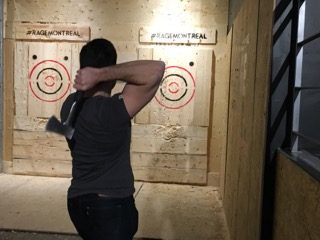Rage Montreal is the perfect place to explore your wild side
Here’s something you might not know—you don’t need to trek three hours into the frigid, rural Quebec countryside to get in touch with your inner gruff, wild and unhinged self. No, as a matter of fact, all you need to do is stop by Rage Montreal, one of the city’s only axe throwing playgrounds located in an urban setting.
Naturally, axe throwing begs a few questions. This is really a thing? Alright, then how do you play? Is it fun? How does it work? Do I run the risk of minor to serious amputation? These are all valid concerns, of course.
Just a hop, skip and a jump away from Berri-UQAM metro on Amherst Street, you’ll find Rage Montreal, the city’s premier axe throwing facility. Entering the space, it quickly dawns on you that this place is no joke. You’re immediately greeted by rustic chain-link fences that divvy up the multiple battered and splintered target zones, while the distinct smells of sawdust and wood chips invade your nostrils. Then, of course, there are the weapons themselves. Gimli from Lord of the Rings would look on in admiration at the number of axes and hatchets of all shapes and sizes lining Rage Montreal’s walls.
You descend the stairs of this lumberjack utopia where you’re required to check in with staff on site. All attendees must reserve a time-slot and specify the number of targets they intend to use in advance. The more targets you want to reserve, the more your session will cost you.
Once you’re settled in, informal axe-wielding lessons begin. There’s no throwing at this stage yet, though. Like any sport, mastering the basic technique comes first. Instructors start by teaching the fundamentals of the sport and the proper form before axes are even brought out.
The floor, two walls and a coloured plywood target stood between the target and me. In training, I was instructed to stand approximately 15 feet from my target behind a demarcated line of tape. According to my instructor for the evening, the tape is a sort of ‘guideline.’
At this point, first-time players are introduced to their axes to get familiar with the weight, grip and feel of the weapons and to learn the all-important axe throwing stance and throw.
Not dissimilar to an en garde fencing position, bending one’s knees ever so slightly, a player’s dominant hand and foot are placed well behind the line of tape while the weaker arm and foot stand forward, on the edge of the line. Axe in hand, I got to practice the motion of the throw. With my dominant foot planted firmly on the floor behind the line and axe-wielding arm at the ready, I was instructed to grip the lowest possible point of the axe’s hilt firmly and crank my arm behind my back with the axe pointing downward, running parallel to my shoulder blades.
Here’s where it gets tricky. A ‘good throw’—in other words, a throw that will make the axe’s blade sink firmly into the wood—must not curve. The throw must align perfectly with the movement of your shoulder and follow an arced-shape trajectory, lest the player risk an embarrassing string of failed attempts.
You start off with the standard axes that most players will use and you get to throwing. Here, the rules are strict but clear. There’s one player per target and no player may throw an axe while another goes to collect his or her weapon.
Once you get the hang of it, the beauty of the sport really comes alive. As the evening went on and the speakers blared all the Black Sabbath hits, we were given larger axes to test our newfound skill with. By the end of the night, I was able to rack up a few very solid throws and two genuine bullseyes.
I may not be joining any of the axe throwing leagues organized by Rage Montreal in the near future or attending any National Axe Throwing Federation events (yes, there is a federation). However, I certainly wouldn’t hesitate to pass by again and give this unique, niche sport another well-deserved go.
Rage Montreal presents an excellent opportunity for passionate axe throwers and novices alike to take part in a fascinating sport in a pleasant atmosphere that allows you to vent out the everyday frustrations and stress of Montreal city-life.
Rage Montreal is open seven days a week from 2 p.m. to 10 p.m., with Tuesdays and Wednesdays reserved for special events and large group activities.
